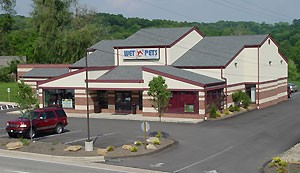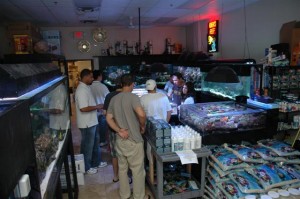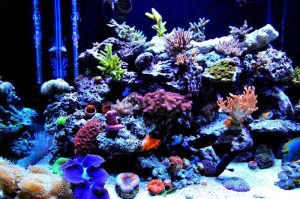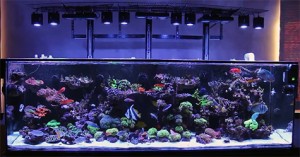 Is retail dying? Not just in the aquarium industry, but across the country and around the world? For so long consumers were limited to products that were accessible, things for sale in our towns and cities. Now, the world is an open shop and nothing is out of reach. It’s changing global economies and re-defining industries. In some cases, it’s pushing small specialty stores to close, and in other cases it’s opening rural areas up to new ventures. The question remains, will aquarists still turn to the local fish store (LFS) through 2016 and beyond? Will marine life sales be dominated by a handful of large, all-inclusive marine outlets? 2016 marks my 15th year writing for marine aquarium publications, with my history dating back to the now defunct Freshwater and Marine Aquarium Magazine (FAMA). I’ve been a fish, coral and aquarium consumer for even longer, and living in a rural part of Maryland, have a unique relationship with both the LFS and online retailers. Will online kill the brick and mortar store down, once and for all?
Is retail dying? Not just in the aquarium industry, but across the country and around the world? For so long consumers were limited to products that were accessible, things for sale in our towns and cities. Now, the world is an open shop and nothing is out of reach. It’s changing global economies and re-defining industries. In some cases, it’s pushing small specialty stores to close, and in other cases it’s opening rural areas up to new ventures. The question remains, will aquarists still turn to the local fish store (LFS) through 2016 and beyond? Will marine life sales be dominated by a handful of large, all-inclusive marine outlets? 2016 marks my 15th year writing for marine aquarium publications, with my history dating back to the now defunct Freshwater and Marine Aquarium Magazine (FAMA). I’ve been a fish, coral and aquarium consumer for even longer, and living in a rural part of Maryland, have a unique relationship with both the LFS and online retailers. Will online kill the brick and mortar store down, once and for all?
Once upon a time:
 We aquarists only had access to equipment and animals within our reach, animals for sale right around our towns or cities. For me, in far Western Maryland, there was no access to marine aquarium equipment or animals. When I was younger, this meant I was limited to freshwater aquariums, and a limited amount of species. Information, livestock and equipment was scarce, and so was information. Internet was in its infancy, mostly accessed at schools or libraries and home dial-up hadn’t yet made its way into my area. Eventually, when I was around 17 and newly licensed to drive, a store about an hour away was carrying marine animals and equipment. Up until that point, I could only keep marine animals I gathered from trips into Pittsburgh, or other cities I rarely travelled too.
We aquarists only had access to equipment and animals within our reach, animals for sale right around our towns or cities. For me, in far Western Maryland, there was no access to marine aquarium equipment or animals. When I was younger, this meant I was limited to freshwater aquariums, and a limited amount of species. Information, livestock and equipment was scarce, and so was information. Internet was in its infancy, mostly accessed at schools or libraries and home dial-up hadn’t yet made its way into my area. Eventually, when I was around 17 and newly licensed to drive, a store about an hour away was carrying marine animals and equipment. Up until that point, I could only keep marine animals I gathered from trips into Pittsburgh, or other cities I rarely travelled too.
So it goes, my progression into and through the hobby was limited by what I could get. My early tanks were crushed coral bottomed, fish only systems with simple hang on back filtration. Not that I didn’t want to have something more advanced, I didn’t have access to it. The LFS relationship was a unique one, and I am still friends with fish shop owners whom I’ve shopped with for 15 or so years. It was a personal relationship, and often the shop owner served as your gateway to not only aquarium livestock and products, but also information. They travelled around the industry, learned new things and incorporated some of those into their shop. It was a fish shop owner that introduced me to VHO lighting and LPS corals, and a fish shop owner that taught me the basics of reef water chemistry.
No internet forum, no arguments online, and limited aquarium publications. Just a simple, “I’ve tried this and it seems to work, it might work for you,” from a fish shop owner and the method was met with either success or failure. People used to stand in fish shops and talk for hours about what worked, what didn’t and the ins and outs in between. It was through this LFS network that I was introduced to fish breeders, reef aquarists and everyone around that was pioneering their way into, and throughout the hobby. It felt sort of cool and unique, like you were part of a small gang trying something entirely new. The LFS often dictated what kind of equipment you favored, Fluval filters or Marineland bio-wheels, what kind of aquariums you liked, All Glass or Marineland on down the line to what livestock you wanted to experiment with. Back in those days there weren’t any arguments, nor where there many people that defended one style of reef keeping over another. Everyone got along fine, shared secrets, traded corals and turned reef keeping into a social event, often with the LFS serving as the central hub.
I remember when using a sump became popular, and the rise of wet/dry filters. I was one of the first customers at my (fairly) local LFS to purchase a wet/dry filter, and I remember fielding questions from fellow aquarists about the results. It was a simple and friendly time to be a reef keeper, but it was limited. You were limited to the knowledge and advice of your LFS owner, or the aquarists that frequented it. A lot of the ideas passed around where hearsay, someone heard this from a friend who had an uncle that met Julian Sprung. Getting your hands on coral in those days was tough, and there wasn’t a ton of variety. I remember when green star polyps were a new and exciting species at the LFS. Often new products were outrageously expensive, and I can remember plunking down quite a bit on a compact florescent light fixture when they were first introduced. All in all, it was a good time and everyone lived with the limitations and with reef keeping being local, it didn’t take much to feel like a reef keeping rock star. Looking back on it, it’s almost sad to know that quite quickly, it is dying.
The rise of the internet:
 Long before I personally ordered a livestock piece, or equipment online, there was chatter in the LFS about shipping live animals. At this time, service to rural areas via UPS was sketchy, and many of us laughed off the prospect of getting a healthy, live animal delivered to our home. Most of the fish store owners I was friends with drove to the Baltimore airport to get their shop’s livestock. None of us really saw the internet livestock thing going far, as we couldn’t imagine shipping infrastructure that could deliver livestock to our area. By now, even the rural area of Maryland where I lived had access to at least dial-up internet, and a T1 line or satellite connection offered much higher speeds. I remember having a large satellite mounted to my parent’s house (yes, in 1995-2001 I lived with my parents) to access high speed internet.
Long before I personally ordered a livestock piece, or equipment online, there was chatter in the LFS about shipping live animals. At this time, service to rural areas via UPS was sketchy, and many of us laughed off the prospect of getting a healthy, live animal delivered to our home. Most of the fish store owners I was friends with drove to the Baltimore airport to get their shop’s livestock. None of us really saw the internet livestock thing going far, as we couldn’t imagine shipping infrastructure that could deliver livestock to our area. By now, even the rural area of Maryland where I lived had access to at least dial-up internet, and a T1 line or satellite connection offered much higher speeds. I remember having a large satellite mounted to my parent’s house (yes, in 1995-2001 I lived with my parents) to access high speed internet.
Though, within time, UPS and Fed Ex expanded, and in fact they opened a large shipping center right in the small city where my (fairly) local LFS was. This shipping center could receive packages from multiple livestock retailers around the U.S., getting them overnight and having them to our doors shortly after lunch. UPS and Fed Ex continued to expand, and within a year or two the shipping center close to my home had connections all the way to California. Reef keeping forums were on the rise as well. Suddenly we could connect with reef keepers all over the U.S., and the entire world. Suddenly the gang at my LFS didn’t feel like reef keeping rock stars, in fact we were reef keeping peons in comparison to what was appearing online. Slowly, less and less people were showing up at the LFS and eventually the levy broke and one of our gang was ordering unique livestock online. To our shock, his animals hadn’t arrived dead, or near death, but healthy and feeding.
It wasn’t long at all till I abandon trips to the LFS in lieu of chatting it up online and ordering equipment and livestock online. Species that we only chatted about and speculated about were now available, arriving at our doors overnight. Via the internet you could track down a handful of aquarium publications and subscribe to them. In order to keep up with the folks online, you needed better equipment, refined methodology and an innate ability to manage water chemistry. It was clear to me, and I am sure many others, that the days of hanging out in the LFS chatting about something someone heard from a friend, were over. Now we could actively take part in reef keeping’s brave new frontier.
Information exploded:
 In 2001 I submitted an article to FAMA magazine. It was about the benefits of quarantining new fish and setting-up a hospital tank. I thought it was a unique approach, as I was one of the few folks at my LFS that did this. I hadn’t read about it via a magazine or book, or found information about it online. I had been through several parasitic outbreaks, and thought it made sense to ensure fish were disease free, before putting them in my display tank. As I was learning online, I hadn’t pioneered hospital tanks, in fact people had been using them for years. I was quite confident FAMA would read one sentence of my article, trash it and forget who I was. To my surprise, they called me several months later and wanted to print the article and were interested in more. It began my journey down the rabbit hole of writing for aquarium publications, a tumble that has yet to end to this day.
In 2001 I submitted an article to FAMA magazine. It was about the benefits of quarantining new fish and setting-up a hospital tank. I thought it was a unique approach, as I was one of the few folks at my LFS that did this. I hadn’t read about it via a magazine or book, or found information about it online. I had been through several parasitic outbreaks, and thought it made sense to ensure fish were disease free, before putting them in my display tank. As I was learning online, I hadn’t pioneered hospital tanks, in fact people had been using them for years. I was quite confident FAMA would read one sentence of my article, trash it and forget who I was. To my surprise, they called me several months later and wanted to print the article and were interested in more. It began my journey down the rabbit hole of writing for aquarium publications, a tumble that has yet to end to this day.
Suddenly I was inside the aquarium industry, and over the course of writing for FAMA interviewed prominent aquarists and marine biologists, and had an insider’s look at up and coming reef aquarium product manufactures. As the internet gained traction and reef keeping grew, forums became bustling communities and everything from coral or fish disease diagnosis, to instructions on how to build or purchase equipment could be found online. Before this, we all relied on Bob Fenner’s book, “The Contentious Marine Aquarist” which many called a reef keeping Bible. As I waded through the aquarium industry writing for FAMA, it was clear when I spoke to many reef retailers that the internet was the future. They saw beyond the horizon of a handful of folks hanging out in the LFS, limited to only the owner’s personal selection of animals. They saw a world where at the click of a button reef keepers could access libraries of information, and whatever livestock they were after.
My tank was changing as well. What was once a sparsely populated reef with a few bland corals, some clams and fish, was becoming more colorful with unique rocks, SPS corals and new species of LPS corals and fish. The hobby was evolving, and the internet was kicking that evolution into high gear.
Today:
 Since those days long passed, UPS and Fed Ex have grown, and now have the ability to ship animals from remote corners of the world. They arrive at central hubs often in California, animals collected from small island nations many Americans don’t realize even exist. Year by year, rare and remote species become more accessible, and new barriers in reef keeping are broken down, often by hobbyists at home. There are a multitude of major reef keeping publications, and an almost limitless supply of forums, blogs and websites. Along with blogs and websites, there is a hearty supply of large coral retailers and fragging has opened the door to propagating species we didn’t know existed 15 years ago. Trips to the airport to pick up livestock are a thing of the past, and apps on our smart phones can notify us if something is amiss within our tank. For reef keeper’s today, the world really is at our finger-tips.
Since those days long passed, UPS and Fed Ex have grown, and now have the ability to ship animals from remote corners of the world. They arrive at central hubs often in California, animals collected from small island nations many Americans don’t realize even exist. Year by year, rare and remote species become more accessible, and new barriers in reef keeping are broken down, often by hobbyists at home. There are a multitude of major reef keeping publications, and an almost limitless supply of forums, blogs and websites. Along with blogs and websites, there is a hearty supply of large coral retailers and fragging has opened the door to propagating species we didn’t know existed 15 years ago. Trips to the airport to pick up livestock are a thing of the past, and apps on our smart phones can notify us if something is amiss within our tank. For reef keeper’s today, the world really is at our finger-tips.
It would seem like all this expansion, growth and free sharing of information would be positive. In many ways, it is. Although it certainly isn’t without some caveats. Not all the information shared online is accurate, researched or even advisable. Not every supposed reef keeping guru truly is, and the tendency for reef keepers to argue and spat over skimmers and lights is prevalent within the hobby. In addition to the handful of remarkable coral vendors, there are those with only a Facebook profile or forum avatar, selling freshly cut frags out of their basement, with no level of customer service. Photo editing software has given rise to photo-shopped corals, tinted and contrasted to appear far more colorful than they really are. On a whim it seems sneaky vendors can makeshift a rare or unique coral piece, tagging on a flashy name and equally as flashy price tag. I remember in the days of the LFS, all corals were around 20 dollars, give or take and 30 for something unusually pretty.
While reef keeping groups and seminars often facilitate frag trading, it’s not near as common as it was back in the days of the LFS. I don’t often hear of aquarists trading coral frags for salt mix or other equipment at the LFS, or trading free frags with their buddies just because it was nice. In fact, coral colonies today are often sold for outrageous prices, for far more than you could get competent equipment for 10 years ago.
In addition, the demand for reef livestock has risen sharply. So sharply that the hobbies’ effect on natural reefs has been called into question. Species that once dwelled only at the ocean’s greatest depths are now netted up, shipped out and put on display in our aquariums. The minute an aquarist accomplishes real world innovation, they patent it, slap a price tag on it and sell it at market value to the masses. The days of trading information and innovation for free are long since passed.
Where is the LFS?
 Off hand, I can think of three of four LFSs that have closed since 2001. One, a shop in Morgantown, WV that I used to frequent, had unbeatable prices and a wide selection. Since I know most of these shop owners, I got a call explaining why they decided to call it quits. Every single one was struggling to keep up with either the internet, or a big box retailer such as Petco. Either the overhead costs of a brick and mortar store were too great, or pricing livestock and products to make a profit pushed the margin over what an aquarist could spend online. Those still in business have in many cases throttled back, relying on bread and butter species and gear for basic, or beginning aquarists. What was once a bustling reef shop has become a deli, or furniture store.
Off hand, I can think of three of four LFSs that have closed since 2001. One, a shop in Morgantown, WV that I used to frequent, had unbeatable prices and a wide selection. Since I know most of these shop owners, I got a call explaining why they decided to call it quits. Every single one was struggling to keep up with either the internet, or a big box retailer such as Petco. Either the overhead costs of a brick and mortar store were too great, or pricing livestock and products to make a profit pushed the margin over what an aquarist could spend online. Those still in business have in many cases throttled back, relying on bread and butter species and gear for basic, or beginning aquarists. What was once a bustling reef shop has become a deli, or furniture store.
Many of these shop owners were ill equipped for the internet age. Their business model was being inside their shop, talking with customers, learning new things and aiding incoming clients. They were often willing to strike a deal on a unique fish or coral and always tested equipment on tanks within their store, so they could aid customers in setting it up on a home tank. They weren’t prepared for print-offs from a website detailing a reduced price, or issuing scathing reviews of equipment they sold. They weren’t prepared for flashy coral names and rare fish shipped from an island they had never heard of. They knew they couldn’t compete with the raging waters of the internet, and realized the golden age of the LFS was over. With that, they sold all their gear at rock bottom prices and closed their doors.
I imagine a handful of LFSs will always remain. I also imagine they will be at one end of a wide spectrum, either bread and butter beginner shops, or high end ultra-rare shops. Some outlets have adjusted to the internet age well, jumping on the bandwagon and selling their goods online. Though the days of the small LFS that had a little bit of everything, where the owner was always behind the register are fading fast. They are a dead and decaying dinosaur of reef keeping’s humble origins.
In many ways, that is a shame. Instead of sulk, I am going to head on over to Live Aquaria’s Diver’s Den and see if they have anything exciting in stock and if I order before 10 a.m., it will be here tomorrow.










Interesting read, In the metropolitan St. Louis area, the number of LPS has increased by 50% in the last two years growing from 8 to 12 with no closures. Except for Diver’s Den with their amazing guarantee, don’t you like to see your fish eat before purchasing them?
John – Yes, I do like to see my fish before purchasing them – if it’s possible. Though I haven’t seen a fish before buying them for several years now. Where I am at, there just aren’t any saltwater outlets with the closest one being over 2 hours away. In referencing LFS’s – I think various areas will always have a handful (give or take) of LFS’s, based on population and the number of aquarists in the area, dedicated to shopping at a specific LFS. Overall though, especially in rural communities and small cities, I think the expansion of shipping outlets and online sales will weed the numbers of LFSs overall. Rural LFSs that carry marine stock, often don’t offer the variety that hardcore aquarists are looking for, largely because they don’t have the population to support it. The hardcore aquarists in those areas (folks like myself) often turn to the internet to get their hands on what they want. Some cities have seen a boom in LFSs, especially those with rare or unique stock, just because the hobby in those areas has grown. Often in rural communities, a shop will either have bread and butter marine fish, or simply carry freshwater only. I think as the internet grows, the number of LFSs in these areas, that offer marine livestock will continue to shrink. A huge factor has been aquarists learning how to acclimate and QT animals shipped overnight, as it’s a bit different protocol.